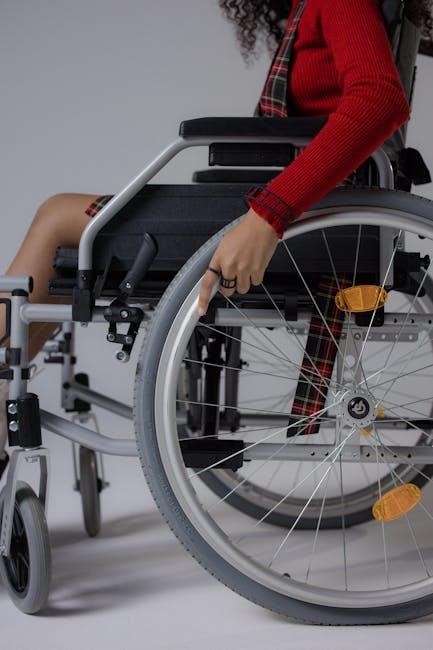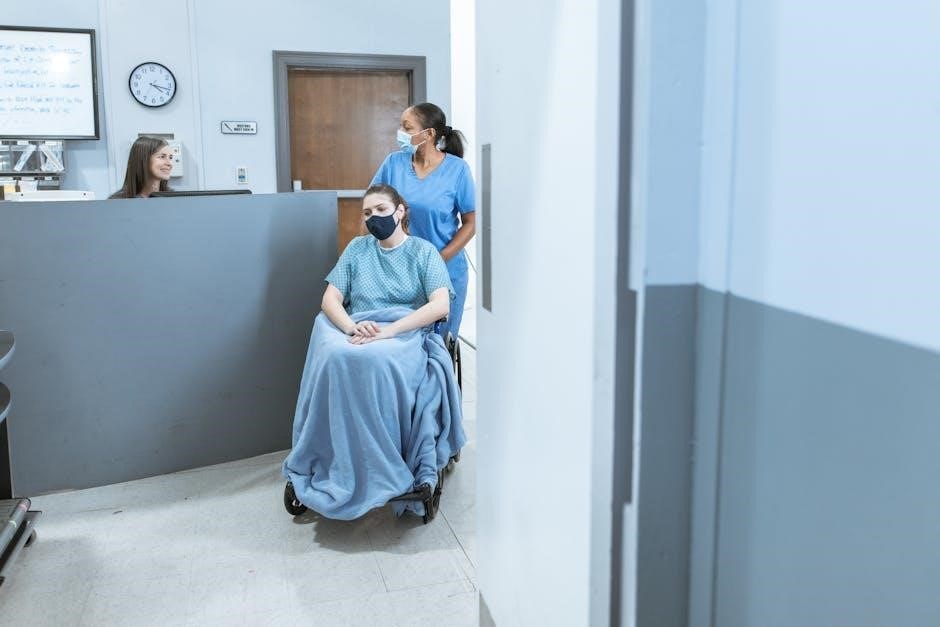Manual handling is a vital skill for disability support workers‚ ensuring safe and dignified care. Proper techniques prevent injuries and promote well-being for both workers and clients.
Definition and Scope of Manual Handling
Manual handling refers to the use of physical strength to lift‚ carry‚ push‚ pull‚ or move loads. It involves transporting or supporting objects by hand or bodily force‚ including lifting‚ lowering‚ and carrying tasks. In disability support‚ it encompasses assisting clients with mobility‚ transfers‚ and daily activities‚ requiring careful technique to ensure safety and dignity for both workers and clients.
Importance of Manual Handling in Disability Support
Effective manual handling is crucial for ensuring the safety‚ dignity‚ and well-being of both disability support workers and clients. It prevents injuries‚ promotes client independence‚ and maintains quality care standards. Proper techniques reduce the risk of musculoskeletal disorders among workers while respecting clients’ autonomy. Adhering to manual handling practices also aligns with legal and ethical obligations‚ fostering a safe and supportive care environment.
Understanding the Risks of Manual Handling
Manual handling poses risks of musculoskeletal injuries‚ sprains‚ and strains due to lifting‚ pushing‚ or pulling heavy loads‚ emphasizing the need for safe techniques.
Identifying Hazardous Manual Tasks
Hazardous manual tasks involve lifting‚ pushing‚ pulling‚ or carrying heavy loads‚ often requiring repetitive movements or awkward postures. These tasks can lead to musculoskeletal injuries‚ particularly in disability support roles where clients may have limited mobility. Assessing the weight‚ size‚ and handling frequency of loads‚ along with the physical environment‚ helps identify risks and prioritize safer alternatives or assistive equipment.
Physical Demands and Injury Risks
Manual handling tasks in disability support often require repetitive movements‚ awkward postures‚ and heavy lifting‚ increasing the risk of musculoskeletal injuries. Workers may experience strains‚ sprains‚ or chronic back pain due to lifting clients with limited mobility. Prolonged exposure to such physical demands can lead to long-term health issues‚ emphasizing the need for proper training and ergonomic practices to minimize these risks and protect worker well-being.

Legal and Regulatory Frameworks
Legal frameworks govern manual handling practices‚ ensuring compliance with safety standards and regulations; Employers must conduct risk assessments and provide training to minimize hazards and prevent injuries.
Key Regulations and Standards
Manual handling in disability support is governed by regulations like the Manual Handling Operations Regulations 1992. These standards require employers to assess risks‚ provide training‚ and implement controls. Compliance ensures worker and client safety‚ minimizing injury risks through proper techniques and equipment use. Adhering to these guidelines is essential for legal and ethical practice in disability care settings.
Employer Responsibilities and Compliance
Employers must conduct manual handling risk assessments‚ provide training‚ and ensure safe practices. They are responsible for implementing controls‚ using assistive devices‚ and monitoring compliance. Adhering to regulations like the Manual Handling Operations Regulations 1992 is crucial. Employers must also ensure staff are competent and that care plans integrate safe manual handling procedures to protect both workers and clients from injury risks.
Safe Manual Handling Techniques
Safe manual handling involves bending at the knees‚ keeping loads close‚ and using team lifting when necessary. Proper posture and balance minimize injury risks for workers and clients.
Best Practices for Lifting and Carrying
Best practices for lifting and carrying involve maintaining a stable posture‚ gripping the load securely‚ and bending at the knees to reduce strain. Keeping the load close to the body minimizes the risk of injury. Team lifting should be used for heavy or awkward loads‚ and regular breaks are essential to avoid fatigue. Proper training ensures these techniques are applied consistently and safely in disability support settings.
Using Assistive Devices and Equipment
Assistive devices and equipment play a crucial role in minimizing manual handling risks. Hoists‚ slide sheets‚ and transfer belts are commonly used to reduce physical strain. These tools enhance safety‚ making it easier to support individuals with disabilities. Proper training on device usage ensures effectiveness and prevents accidents. Prioritizing equipment maintenance and selection based on client needs further optimizes care delivery and workplace safety for disability support workers.
Assessment and Planning
Assessment and planning are crucial steps in identifying and mitigating risks associated with manual tasks. They involve evaluating tasks‚ developing strategies to minimize risks‚ and ensuring safe practices.
Conducting Manual Handling Risk Assessments
Conducting manual handling risk assessments involves identifying tasks that could cause injury‚ evaluating the environment‚ and considering individual client needs. Assessors analyze the load‚ task‚ and worker capabilities to determine risks. This step ensures that strategies to minimize hazards‚ such as using assistive devices or adjusting workflows‚ are implemented effectively. Regular reviews and updates to assessments are essential to maintain safety standards and adapt to changing circumstances.
Integrating Manual Handling into Care Plans
Integrating manual handling into care plans ensures personalized support for clients with disabilities. Tailored strategies‚ such as specific lifting techniques and equipment use‚ are outlined to meet individual needs. Collaboration between support workers and healthcare professionals is crucial for effective implementation. Regular reviews and updates ensure plans adapt to changing client requirements‚ promoting safety and well-being. This approach minimizes risks and enhances the quality of care provided‚ aligning with legal and safety standards.

Training and Education
Structured training programs equip disability support workers with practical skills and knowledge to perform manual handling safely. Education focuses on proper techniques‚ risk assessment‚ and equipment use.
Manual Handling Training Programs
Training programs emphasize safe lifting‚ carrying‚ and transferring techniques. They include theoretical and practical sessions‚ focusing on proper posture‚ load assessment‚ and equipment use to minimize injury risks. These programs are tailored for disability support workers‚ ensuring they can provide care safely and effectively. Regular updates and refreshers are essential to maintain competency and adapt to new guidelines or equipment.
Practical Skills and Competency Development
Practical training focuses on developing hands-on skills in manual handling‚ such as proper lifting techniques and the use of assistive devices. Competency assessments ensure workers can apply these skills safely. Simulated scenarios help build confidence and adaptability‚ preparing workers for real-life challenges in disability support settings.

Risk Control Strategies
Risk control strategies involve eliminating or minimizing manual handling hazards through ergonomic workplace design and engineering controls‚ ensuring a safer environment for disability support workers and clients.
Elimination and Minimization of Risks
Eliminating risks involves removing hazardous manual tasks where possible‚ such as using mechanical aids to lift clients. Minimizing risks includes adjusting workplace layouts‚ reducing load weights‚ and implementing team lifting. These strategies ensure safer working conditions for disability support workers‚ reducing the likelihood of injuries and enhancing overall well-being. Proper training and equipment are essential for effective risk reduction.
Engineering Controls and Workplace Design
Engineering controls and workplace design play a crucial role in reducing manual handling risks. Installing hoists‚ adjustable beds‚ and transfer equipment minimizes the need for manual lifting. Ergonomic workplace layouts ensure efficient workflows‚ reducing strain. Designing spaces to accommodate assistive devices enhances safety and efficiency‚ creating a safer environment for both disability support workers and clients. Proper design fosters a proactive approach to injury prevention and improved care delivery.

Reporting and Incident Management
Accurate documentation of manual handling incidents is essential for identifying risks and improving safety protocols. Timely reporting ensures incidents are investigated and learned from‚ enhancing future care.
Documenting Manual Handling Incidents
Accurate documentation of manual handling incidents is critical for identifying risks and improving safety. Records should include date‚ time‚ location‚ and details of the incident‚ including injuries sustained. Documenting the actions taken‚ such as first aid or medical referrals‚ ensures transparency and accountability. Witness statements and equipment involved should also be noted. Proper documentation aids in incident investigations‚ risk assessments‚ and future training programs to prevent similar occurrences.
Investigating and Learning from Incidents
Investigating manual handling incidents involves analyzing root causes‚ such as poor techniques or equipment failure. Documenting findings helps identify patterns and implement corrective actions. Conducting thorough investigations ensures accountability and transparency‚ while sharing lessons learned promotes a safety-first culture. This process supports continuous improvement in care delivery and reduces future risks‚ ultimately enhancing both worker and client well-being.
Manual handling for disability support workers requires proper assessment of tasks‚ use of correct lifting techniques‚ and utilization of assistive devices. Prioritizing client-centered care ensures safety and dignity. Training and risk assessments are critical to minimize hazards. Employers must provide resources and support to maintain a safe working environment. Balancing legal compliance with practical strategies ensures effective manual handling practices for both caregivers and clients.
Future Directions in Manual Handling for Disability Support
Future advancements in manual handling for disability support workers emphasize integrating technology‚ such as robotic assistive devices‚ to reduce physical strain. Enhanced training programs focusing on personalized care and ergonomic practices will become standard. There will also be a greater emphasis on proactive risk management and policy updates to ensure safer environments for both workers and clients‚ fostering a culture of continuous improvement and innovation in care delivery.
